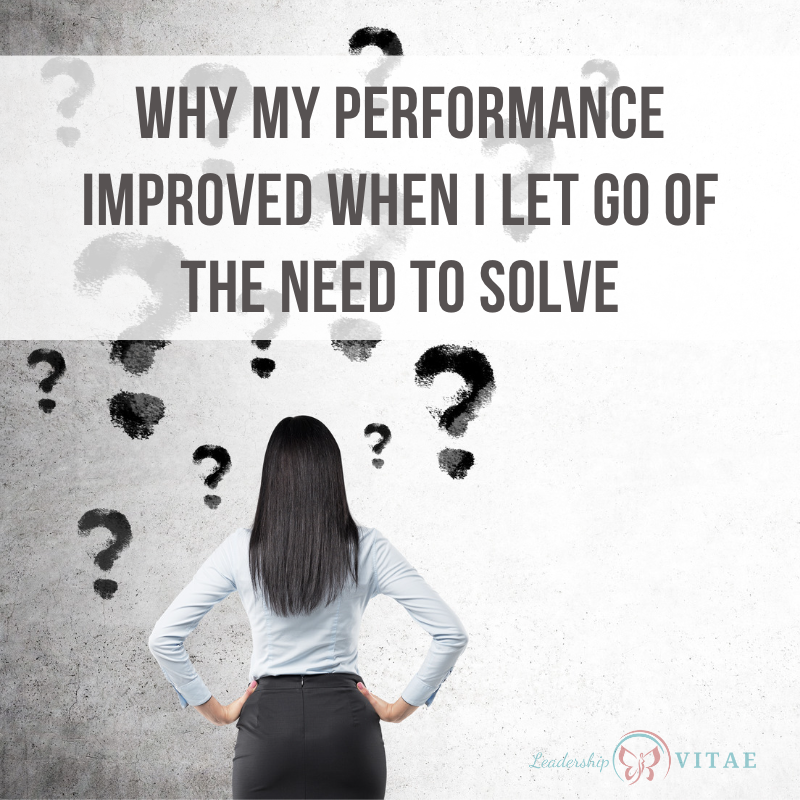
A few months ago, I completed my coaching accreditation with ICF. It officially began in 2017 when I started a coaching program at the University of New Hampshire. In reality, it began in the early years of my career when I felt called to help Marines make transition decisions at the end of their enlistments.
Coaching Marines took a lot of the same skills needed to navigate the military environment. I could be no-nonsense, stick to the facts as I saw them, and ask pointed questions to help them gain clarity on their decisions. The goal was to solve a very present problem within a clear timeframe. Emotions? Not even remotely in the mix.
At least that’s how I look back at it. I was outside the problem and could offer a rational and dispassionate way to frame things. Now I realize the decisions they made took the insights and layered them with emotion to determine their course of action.
Fast forward a lot of years, and I still tend to be a problem solver. I don’t think you can be a successful technology and change leader without that skill. However, it doesn’t always serve me as a coach (or leader). That was the challenge as I pursued my accreditation.
Problem-solving has limitations
Problem-solving skills have gotten me to where I am in my career. There is no doubt that pattern recognition, risk awareness, agility…I personify the military mantra of “adapt and overcome.”
In some cases, that has also made me a great leader, as I look at the hill we are trying to take and can quickly find ways over, around, or through obstacles we face. However, it hasn’t always created great leaders in my organizations.
Facts.
Somewhere along the way, I realized that I needed to let others evaluate the same terrain and determine what actions they would take. From the safety of my leadership. I’d still be there to make sure we didn’t crash and burn (at least not to the point we couldn’t recover). However, if I never let them evaluate the situation first, make the call, and occasionally fall down with my help to get back up, what would happen when it was time for them to lead?
From a leadership perspective, this made sense and is something I’ve done my best to practice and remind myself of for 20+ years. As a coach, however, it’s taken longer for me to remember and practice…the person that solves gets an opportunity to be empowered, accountable, and grow.
And that means more than the joy I get when I solve.
Getting ego out of the way
From the start of my career, I didn’t really fit. The young, female, civilian in a sea of Marines…I was not someone folks wanted to follow. Problem-solving was something I was really good at and gave me a reason to be at the table.
That mindset had me convinced it was what would get me to and keep me at the table in every new role or organization. It’s what I thought I needed to provide my team members, peers, or leader in order to fit.
Somewhere along the way, my leadership shifted from the problem (build that software) to the people (what does the team need to solve the customer’s problem). Yet I still solved problems. My team members would regularly bring me problems and ask me to solve them.
It felt good. Like I was needed. Yet it wasn’t building capabilities in my team. So I had to let go of my ego to help them unlock what they knew. I had to shift the good feelings I got solving to helping someone else solve.
Yet in coaching, I still had a place where I could solve! I love a puzzle and a good problem. Giving that up in my leadership meant I had all this energy to apply somewhere. Where better than as a coach, where folks were faced with problems they wanted help solving?
Except the same issue held. I wasn’t actually helping the person build their own strengths, take accountability, and feel empowered. I needed to face my ego – again – and give it other places to solve and fix. When it comes to people, they aren’t a problem to fix or puzzle to solve. They are whole and complete with the power within them to tackle their struggles head on.
Permission to discover vs solve
As I approached the end of my program, I’d bring recorded sessions for evaluation by instructors and seasoned coaches. In one of those sessions, the instructor gave me the greatest gift. An unlock that lifted a whole lot of expectations I was carrying off my shoulders.
“Kristin, most of the coaching work happens in between sessions. You can’t expect to get to a solution in 30 minutes. What you want is one insight that will help the client move forward.”
Oh.
As a problem solver, I was thinking I had to do x, y, and z in 30 or 60 minutes. Yet I knew from my own experience being coached that the best sessions were when I walked away with an AHA moment and then did my own work afterward.
It was the mining around that was important. I could solve for myself. I’m a problem solver after all. Well, what about my clients? If they could solve on their own, what good do I provide?
Discovery.
The goal isn’t for me to solve. It’s to help someone discover. And if I change the goal from a solution to asking a powerful question that gets them thinking differently? To an insight that they can use to move forward? Well, let’s just say the pressure of somehow coaching a “perfect” session for my final exam got a lot more realistic.
And completely changed my coaching outcomes.
The best outcomes don’t center the coach (leader)
One of my clients is also a solver. A fast-talker, looking for answers and not interested in going too far below the surface. Though she knows that’s exactly where she’ll find the path to meaningful change.
We did a lot of great work over the course of several months. Yet there was one area where she felt stuck. Lots of activity, but not a lot of progress.
Coming out of that coaching class, I asked if we could try something different. Rather than try to come up with “the answer” in our time together, we’d pursue one meaningful insight. Just one.
We slowed down. A lot. That fast-talking became quiet reflection. When she’d ask my thoughts on a situation, I’d guide it back to her insights. Rather than offer solutions, we would focus on her ideas, potential obstacles, and the support she’d need.
While it was slower and there were fewer aha moments, what came up was deeper and more impactful. We could feel the shift in the air. In our interaction. And in her.
Ironically, one of the things she struggled with most was getting others to solve so she didn’t have to. Suddenly she had a model of how to step out of the way and support her people as a coaching leader.
Now, I no longer chase the joy of solving. Instead, it’s the joy of helping others unlock their gifts, insights, and possibilities. Helping and inspiring leaders to do the same. And couldn’t the world use more of that?








